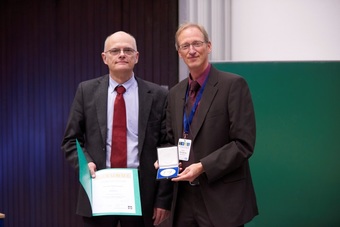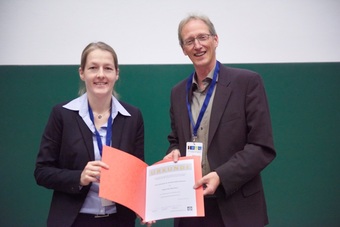Zwei Tagungen zur Weichen Materie am Physik-Department
48. Hauptversammlung der Kolloid-Gesellschaft „Multi-responsive Systems“
3. Workshop ”Fluorescence Correlation Spectroscopy in Soft Matter Science”
2017-11-02 – Nachrichten aus dem Physik-Department

Alle zwei Jahre findet die Hauptversammlung der Kolloid-Gesellschaft statt, einer der ältesten wissenschaftlichen Gesellschaften Deutschlands. Als Kolloide werden winzige Teilchen oder Tröpfchen bezeichnet, die in einem Medium fein verteilt sind und deren Größe typischerweise im Nano- oder Mikrometerbereich liegen. Neben der Grundlagenforschung und Pharmazie haben Kolloide auch eine große Bedeutung in der Nahrungsmittel- und Kosmetikindustrie. Milch ist beispielsweise eine komplexe Mischung verschiedener Kolloide und weiterer Substanzen in Wasser.
Dieses Jahr fand diese Kolloid-Tagung am Physik-Department der TUM statt und stand unter dem Thema “Multiresponsive Systeme”. In diesem interdisziplinären Forschungsgebiet wird auch vor Ort, am Physik-Department, in der Chemie und am Maier-Leibnitz-Zentrum intensiv geforscht. Die Tagung und der Workshop wurden von Christine M. Papadakis (TUM), Peter Müller-Buschbaum (TUM) und Dominik Wöll (RWTH Aachen) organisiert.
Responsive („smarte“) Materialien reagieren auf einen äußeren Reiz (z.B. eine geringe Änderung der Temperatur oder des pH-Werts) mit einer starken Änderung z.B. ihres Volumens oder ihrer Struktur. Multiresponsive Systeme reagieren auf mehrere Reize und beruhen auf der Kombination mehrerer, in verschiedener Weise responsiver Polymere oder Kolloide. Sie versprechen zahlreiche Anwendungen, z.B. als injizierbare Gele für den medizinischen Wirkstofftransport oder als smarte Emulgatoren.
Diese Herausforderungen wurden auf der diesjährigen Kolloid-Tagung von den ca. 150 teilnehmenden Wissenschaftlerinnen und Wissenschaftlern intensiv diskutiert. Namhafte internationale Wissenschaftlerinnen und Wissenschaftler hielten exzellente Vorträge. Etwa die Hälfte der Teilnehmer waren Studierende sowie Doktorandinnen und Doktoranden.
Beim Conference Dinner im Augustinerkeller spielte die Ramersdorfer Tanzlmusi traditionelle bayrische Musik, dazu gab es bayrisches Bier und Essen.
Preisträger der Kolloid-Gesellschaft
(Alle Photos: W. Schürmann/TUM)
Auf der Tagung wurden auch die Preise der Kolloid-Gesellschaft vergeben:
- der Ostwald-Preis an Reinhard Lipowsky (MPI für Kolloid- und Grenzflächenforschung, Potsdam),
- der Steinkopff-Preis an Rainer H. Müller (FU Berlin),
- der Liesegang-Preis an Regine von Klitzing (TU Darmstadt) und
- das Zsigmondy-Stipendium an Annette Andrieu-Brunsen (TU Darmstadt).
- Die Springer Lecture wurde von Mitsuhiro Shibayama (University of Tokio, Japan) gehalten.
- Der Springer Posterpreis wurde Qimeng Song (Uni Siegen) verliehen.
3rd Workshop FCS in Soft Matter Science

Die Fluoreszenz-Korrelations-Spektroskopie (FCS) ist eine äußerst empfindliche Methode zur ortsaufgelösten Bestimmung der Dynamik in weichen Materialien und bietet sich daher auch zur Untersuchung multiresponsiver Systeme an. Der eintägige Workshop war geprägt von intensivem Austausch über die Möglichkeiten dieser Methode im Bereich der Polymer-, Kolloid- und Lebenswissenschaften. Der Workshop, an dem ca. 40 Wissenschaftler teilnahmen, diskutierte unter anderem die Anwendung der FCS zur Charakterisierung der dynamischen Eigenschaften künstlicher Zellmembranen oder des Einflusses von Blutproteinen auf polymere Nanopartikel, die für die Chemotherapie eingesetzt werden.
Verwandte Meldung
Weitere Informationen
- Homepage der Tagung: http://www.kolloid17.ph.tum.de
- Tagungsnachlese (auf englisch)
- Kolloid-Gesellschaft
Webseiten der veranstaltenden Gruppen



